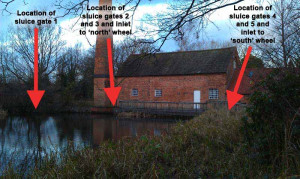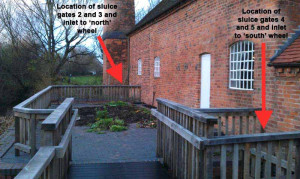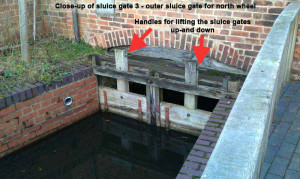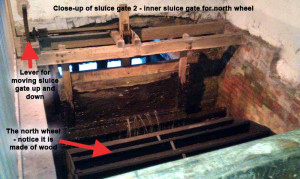Sarehole Mill in Moseley – once the childhood haunt of JRR Tolkien – is to receive three new sluice gates.
Martin Mullaney – Birmingham City Councillor for Moseley and Kings Heath – reports that the millpond behind Sarehole Mill, which feeds one of the two mill wheels, is nearly silted up. Unless something is done to clear the millpond in the next two years, the one operating wheel will have to be stopped permanently. The installation of these three new sluices in the coming weeks should be seen as phase 1 of the de-silting process for the pond. Once the pond is cleared, it will attract more wildlife and potentially offer the opportunity to use the second wheel as a hydroelectric generator.
The millpond was once 1metre-deep stretching some 50metres from the Mill to Wake Green Road. The water source for the millpond is a spring hidden underneath the junction of Billesley Lane and Greenhill Road. Presently, two-thirds of the millpond is completely silted, with trees growing in it, while the small remainder is only 6 inches deep.
Before the de-silting process can begin, three dilapidated sluice gates that are either broken or on the point of complete collapse require renewal; failure would lead to emptying the millpond and flooding the mill.
Sarehole Mill has two water wheels – the northern most one is still in operation and can be seen slowly spinning whenever the mill is open to the public. The ‘south wheel’ is hidden from public view and has not operated since at least 1969.
Sarehole Mill has five sluice gates. These are nothing more than thick planks of oak wood that can be raised or lowered to controls the water flow into the water wheels.
The five sluice gates are located as follows:
- Sluice gate 1 – Millpond overflow, by passing both wheels – this is permanently stuck shut
- Sluice gate 2 – North wheel – inner sluice gate – this is permanently stuck half open
- Sluice gate 3 – North wheel – outer sluice gate – this is still operational and can moved up-and-down
- Sluice gate 4 – South wheel – inner sluice gate – this is permanently shut
- Sluice gate 5 – South wheel – outer sluice gate – this is completely rotten, permanently shut and in danger of collapsing
The proposal is to replace sluice gates 1, 3 and 5
Replacing sluice gate 1 will allow the mill to lower the millpond level in the event of heavy rainstorms. The mill has been flooded several times in recent years, due to the present gate stuck shut.
Replacing sluice gate 2 will allow closure of sluice gate 3 giving the chance to do regular maintenance on it. Additionally it will be possible to regularly remove silt from the millrace in between sluice gates 2 and 3.
Replacing sluice gate 5 will prevent a complete collapse of the gate and subsequent drainage of the millpond. It will also allow a start towards making the south wheel operational. The long-term aim is to connect this wheel to a generator to supply electricity for nearby houses.
De-silting will allow the north wheel to rotate more quickly. At the moment, it is kept to spinning as slowly as possible in order to prevent sucking any silt from the pond onto the waterwheel. There is a problem with silt gradually building up underneath the waterwheel and in the tailrace leading from the wheel. Having the opportunity to do fast bursts of water will allow flushing this silt out.
The cost of de-silting the pond is approximately £200,000. Birmingham Council already has £50,000 towards this from the Birmingham Museums and Art Gallery Development Trust.
The three sluice gates will be replaced by the end of March.
Sarehole Mill is one of the last two watermills within the boundary of Birmingham – the other being New Hall Mill in Walmley, Sutton Coldfield.
Up until the 1850s, there were approximately 90 watermills in operation in the modern boundary of Birmingham. Many of the millponds that powered these watermills still exist in our parks as boating ponds, for example Swanshurst Park, Cannon Hill Park and Trittiford Mill.






